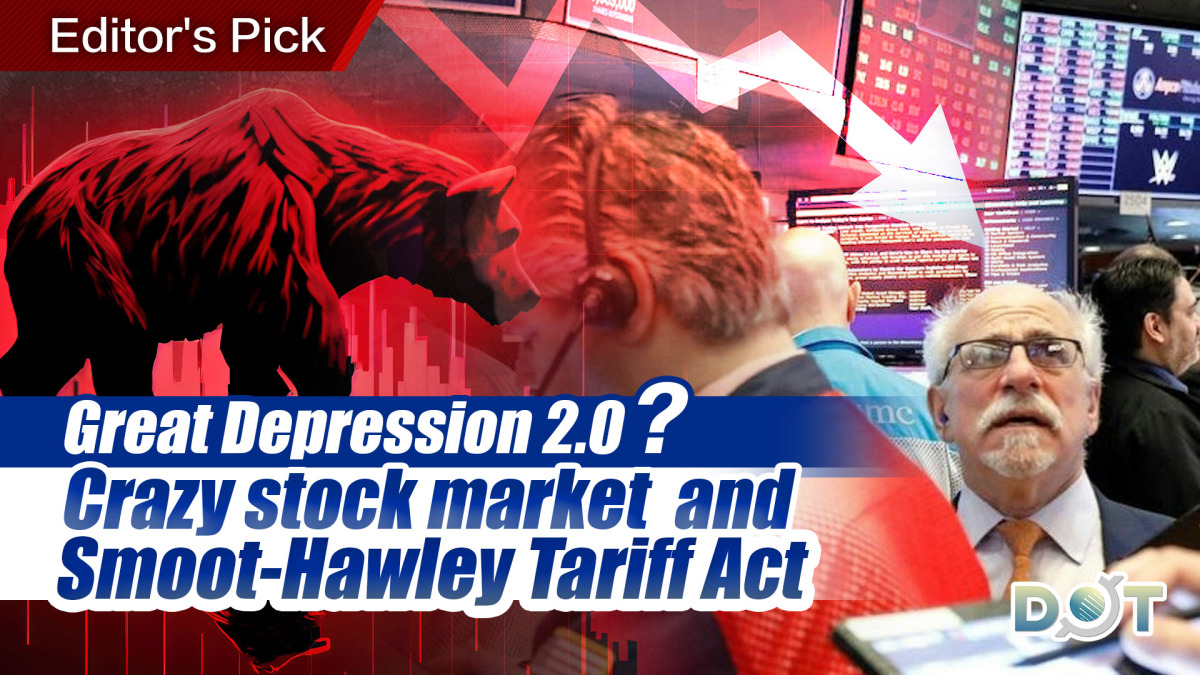
By Liu Yu
In 1930, the U.S. enacted the Smoot-Hawley Tariff Act, raising import tariffs to historic highs, which triggered retaliatory tariff wars globally. Within three years, U.S. exports plummeted by 66%, and world trade shrank by nearly two-thirds, significantly worsening the Great Depression.
Economists widely view this act as "the most severe policy mistake of the 20th century." As the Great Depression began in 1930, the Smoot-Hawley Tariff Act raised tariffs on over 20,000 imported goods to unprecedented levels, leading to reciprocal retaliation from European nations and a collapse in global trade. U.S. imports dropped sharply from 4.4 billion in 1929 to 1.5 billion in 1933, while exports fell from 5.4 billion to 2.1 billion. Between 1929 and 1934, the scale of world trade declined by approximately 66%.
Background of the Great Depression: Crazy Stock Market
Between 1927 and 1928, the stock market nearly doubled, driven by leveraged buying and high price-to-earnings ratios, signaling a classic bubble. Wall Street's economy expanded by 50%, with stock market leverage soaring, much of it from off-regulation systems. Banks made high-risk leveraged funds appear safe through asset repackaging, often without real stress tests, leading to significant profits for bankers and speculators.
The Great Depression was worsened by this financial system. By 1929, telephone loans and investment trusts became key financing channels, rapidly turning into a leveraged debt market with fluctuating interest rates. This created mismatches between assets and liabilities, allowing borrowers to obtain short-term loans based on long-term risks. Many new investors recognized the opportunity, and by 1928, this market accounted for 24% of lending outside the Federal Reserve, rising to 58% by October 1929. Alarmingly, these institutions lacked liquidity protection from the Fed, as household leverage ratios surged alongside stock market gains.
Trusting market forces?
From 1920 to 1929, the U.S. gross national product grew by 42.1%, household income rose by 18.9%, and manufacturing efficiency increased by 40%. This period saw American wealth outpace global standards, with few countries today matching the living conditions of Americans a century ago. Economists credited this growth to "trusting market forces," allowing the market to self-regulate.
As larger companies dominated smaller ones, monopolists like Rockefeller and J.P. Morgan emerged, while smaller firms struggled. Labor exploitation caused wages to lag behind GDP growth, widening the wealth gap; by 1929, 0.1% of the population owned 25% of the nation's wealth, and 60% of families lived below the poverty line.
To combat insufficient consumer spending, capitalists and banks introduced consumer loans, enabling Americans to buy goods without worrying about account balances. While installment buying became popular, it led to reliance on future income and significant debt. Despite growing inequality, this trend fueled consumption, with over 70% of cars purchased on credit.
In 1929, there were over 70,000 stock brokers, and stock prices rose by an average of 61% in two years. Daily trading volume on the New York Stock Exchange reached $97.8 billion, and the average stock return was 4.1 times, while average wages increased by less than 12%. Investors needed only a 25% margin, borrowing the rest from banks at high interest rates.
Over-reliance on the profitability of stock trading
Due to the profitability of stock trading, investment banks and commercial banks became stock promoters, even sending employees door-to-door. This led to 30 million households participating in trading, creating a nationwide frenzy. Many Americans were unaware of the underlying reasons for the stock market's growth, believing prices would continue to rise. Economist Irving Fisher claimed that stock prices had entered a phase of perpetual growth, while President Hoover assured the public of an imminent end to poverty.
However, just a month after Hoover took office, the market peaked. In response to speculation, the U.S. government increased its intervention, causing a massive crash as funds fled. The Dow Jones fell from 381.17 to 41.22, a staggering 90% drop, with many investors caught off guard by excessive leverage.
The false prosperity of the Great Depression was rooted in unlimited dollar inflation. Since the Federal Reserve's establishment, banks had lowered reserves to 10%, increasing the money supply by 60%. Mandated deposits with the Fed centralized reserves, creating a multiplier effect that boosted the money supply significantly. From 1921 to 1929, the government raised the money supply by an average of 7.7% annually.
The Great Depression's horror was its impact on all industries, leading to falling prices, widespread business failures, and massive layoffs as countless workers lost their jobs.
Economic crisis as a 10-year cycle of hardship
An unemployment rate over 4% signals a crisis, while exceeding 10% indicates a major recession; over 20% corresponds to the Great Depression. The severity of the 1929 Great Depression is evident in the data: 85,000 businesses went bankrupt, and unemployment peaked at over 26%. Around 34 million Americans had incomes close to zero, and average wages fell from US$681 in 1929 to US$495 by 1933.
The U.S. gross national income dropped from US$81 billion to US$41 billion, industrial output fell by 47%, and real GDP decreased by 30%. Nearly half of the banks failed, wiping out over 9 million savings accounts overnight. The history of U.S. economic development reflects a cycle of hardship, with crises occurring roughly every ten years, the most significant being the 1929 Great Depression.
While the 2007 subprime crisis also impacted the economy, recovery came quickly, unlike the Great Depression, which lasted nearly a decade. The cause of the 1929 crisis, in Marx's view, lies in the contradiction between private ownership of production and its socialization. Wealth concentration limited the average person's purchasing power, leading to unsold goods and business closures. In 1929, telephone penetration in households reached 40%, and automobile ownership hit 90%.
Reshaping social landscape and redistributing wealth upward
Hoover and Roosevelt adopted similar strategies to tackle the Great Depression, focusing on expanding credit, limiting immigration, providing unemployment relief, and launching major infrastructure projects like the Hoover Dam and the Golden Gate Bridge. A key misstep by Hoover was the Smoot-Hawley Tariff Act of 1930, which raised tariffs to 40% to protect U.S. industries. This led to retaliation from Europe, halving U.S. exports and worsening unemployment as companies moved abroad.
The Federal Reserve also played a significant role. After the crash, half of U.S. banks failed, leading people to hoard cash instead of depositing it. This caused a liquidity crisis and deflation. When Roosevelt took office, he abandoned the gold standard and raised the discount rate, further tightening the economy.
Fortunately for Roosevelt, World War II allowed the U.S. to recover by selling arms. The Great Depression marked a pivotal moment for the U.S. economy, reshaping the social landscape and redistributing wealth upward, despite politicians' claims of helping the populace.
Conclution
The recent U.S. decision to impose additional tariff barriers appears aimed at revitalizing domestic manufacturing. However, the outcome has been more nuanced than intended. Rather than a large-scale return of production to the U.S., there has been a shift from offshore outsourcing to nearshore outsourcing, with manufacturing growth in countries like India even surpassing that of the U.S. The relocation of parts of the Chinese supply chain has primarily benefited nations such as India, Vietnam, and Mexico, rather than bringing jobs back to American soil. This suggests that globalization remains deeply entrenched, and the idea of "de-globalization" may be more theoretical than practical unless the U.S. can present a viable alternative model.
Meanwhile, on April 4, California Governor Gavin Newsom expressed opposition to the new federal tariffs, announcing plans to form strategic alliances with countries affected by U.S. trade policies while advocating for exemptions for California-made goods. His remark-"California is not the same as Washington, D.C."-raises questions about whether the federal government can achieve internal consensus before implementing aggressive trade measures. A fragmented domestic stance could weaken the U.S.'s unified position in international trade, much like the challenges faced by China's late Qing Dynasty when regional divisions undermined national policy cohesion.
Given that globalization continues to define the modern economy, unilateral actions by the U.S. risk creating broader instability. If such policies persist without coordination, there is concern over whether they could inadvertently trigger economic disruptions reminiscent of past crises.
Related News:
Trump denies stock market manipulation amid sell-off, says 'taking medication' at times of decline




















Comment